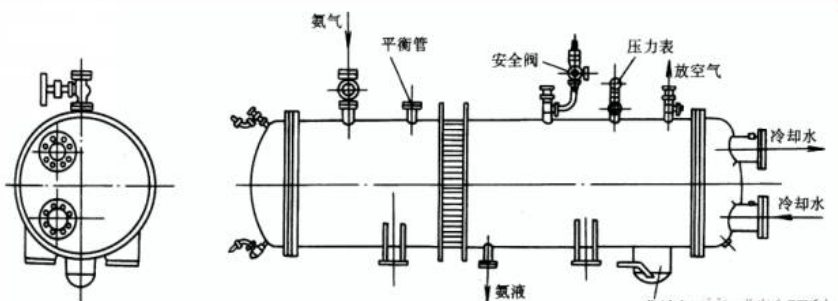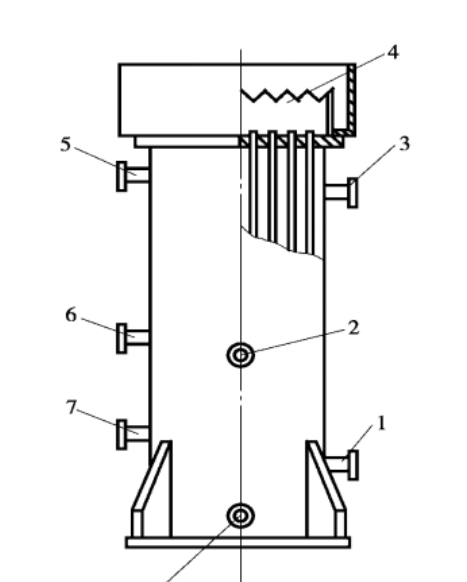Condenser is one of the main heat exchange equipment in refrigeration unit. Its task is to discharge high pressure superheated refrigerant vapor from the compressor, through which heat is released to the environmental medium and cooled, condensed into saturated liquid, or even supercooled liquid.
According to the different cooling medium and cooling method used by the condenser, there are three kinds of water-cooled, air-cooled and water-air cooled.
Condenser cooling mode:
Air-cooled, water-cooled, evaporation-cooled (water-air cooled)
According to the air flow mode outside the pipe in the air cooled condenser:
Natural convection air cooled condenser, forced convection air cooled condenser
First, water cooled condenser
This type of condenser uses water as the cooling medium to take away the heat released when the refrigerant condenses. Cooling water can be used once or recycled.
When circulating water is used, cooling towers or cold pools must be equipped to ensure that the water is constantly cooled. According to its different structure, there are mainly shell and tube type and tube type and plate heat exchanger now used.
Horizontal shell and tube condenser
1. Shell and tube condenser:
Different refrigerants are used in refrigeration equipment, and their structural characteristics are also different. Generally, vertical shell and tube condensers are suitable for large ammonia refrigeration units, while horizontal shell and tube condensers are generally used in large and medium ammonia or freon refrigeration units. The tube plate and the heat transfer tube are generally fixed by expansion method, so as to facilitate the repair and replacement of the heat transfer tube.
2. Characteristics of horizontal shell and tube condenser:
High heat transfer coefficient, less cooling water consumption, easy operation and management; But the water quality of cooling water requirements are high. This kind of device is widely used in large and medium refrigeration units at present.
Vertical shell and tube condenser
1 – liquid outlet pipe; 2 — pressure gauge connector; 3 – intake pipe; 4 – water distribution tank; 5 – safety valve joint; 6 – pressure equalizing pipe; 7 – empty pipe; 8 — Tubing
3. Casing condenser:
It is a water-cooled condenser made of tubes of different diameters which are sheared together and bent into a spiral shape or a snake shape. As shown in the figure, the refrigerant vapor is condensed between the sleeves, and the condensate is drawn out from below. The cooling water flows bottom-up in the small-diameter pipe, forming a countercurrent type with the refrigerant, so the heat transfer effect is better.
Tube condenser
4. Plate condenser:
Plate condenser is made of a series of stainless steel corrugated plates, which forms a cold and hot fluid channel on both sides of the heat transfer plate, and carries out heat transfer through the plate wall in the flow process.
The thickness of the heat transfer plate is about 0.5mm, and the plate spacing is generally 2-5mm.
Plate heat exchanger is small in volume, light in weight, high in heat transfer efficiency, less refrigerant required, high in reliability and has been widely used in recent years. But its internal volume is small, the condensed liquid refrigerant should be eliminated in time, the cooling water quality requirements are high, difficult to clean, internal leakage is not easy to repair.
The cooling water goes up and down, the refrigerant vapor enters from above, and the liquid refrigerant flows out from below.
Two, air cooling condenser
The condenser uses air as the cooling medium. The refrigerant is condensed in the pipe, and the air flows outside the pipe to absorb the heat released by the refrigerant vapor in the pipe. Because of the low heat transfer coefficient of air, fins are often set outside the tube (air side) to enhance heat transfer outside the tube. There are two types of air free flow and air forced flow.
1. Air cooling condenser with free flow of air:
The condenser uses air flowing outside the tube to absorb the heat emitted by the refrigerant. The change in density causes the free flow of air and constantly takes away the condensation heat of the refrigerant vapor. It does not need a fan, no noise, more used in small refrigeration units. As shown in the picture below:
Air cooled condenser with forced air flow: As shown in the figure below, it consists of one or more sets of snaked tubes with fins. The refrigerant vapor enters the snake tube from the upper collector, and the outer fin of the tube is used to strengthen the air side heat transfer and compensate for the low heat transfer coefficient of the air surface.
In terms of structure, the more tube rows along the direction of air flow, the smaller the heat transfer of the back row, so that the heat transfer capacity can not be fully utilized. In order to improve the utilization rate of heat exchange area, it is better to choose 4-6 rows of pipes.
2. Comparison between air cooled condenser and water cooled condenser:
(1) In places where cooling water is sufficient, the initial investment and operating cost of water-cooled equipment are lower than that of air-cooled equipment;
(2) Due to the high outdoor air temperature in summer, the condensation temperature can generally reach 50℃. In order to obtain the same cooling capacity, the capacity of refrigeration compressor of air-cooled equipment needs to be increased by about 15%;
(3) The refrigeration equipment system using air cooled condenser is simple, which can relieve the water shortage;
Three, evaporative condenser
1. Evaporative condenser:
With water and air as the cooling medium. It uses water evaporation to absorb heat to condense refrigerant vapor in the pipe. Water is lifted by the pump and then sprayed to the outer surface of the heat transfer tube by the nozzle to form a water film. Part of the water absorbing heat evaporates into water steam, and then is taken away by the air entering the condenser.
Water droplets that do not evaporate fall into a pool below. A water baffle is arranged above the box body. Used to prevent water droplets from escaping in the air. The structure principle of evaporative condenser is shown in the figure.
2. Characteristics of evaporative condenser:
(1) Using water vaporization to take away condensation heat, the cooling water consumed is only the lost water recharge, cooling water consumption is small;
(2) The inlet air wet bulb temperature of evaporative condenser has a great influence on heat exchange. For the same condensing temperature and air volume, the smaller the inlet wet bulb temperature is, the greater the evaporation of cooling water is, and the better the condensation effect is.
(3) Evaporative condenser has small water consumption, and the air required is less than 1/2 of the air cooled type, so it is especially suitable for dry areas with water shortage.
Post time: Feb-02-2023








